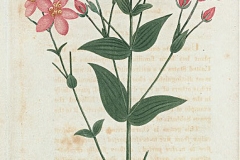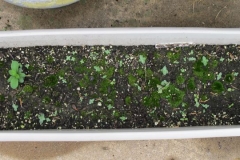It is found on the wet sand of lakeshores and moist or grassy swales which are associated with former lakeshores areas including intermittent wetlands, coastal plain marshes and even dune pannes. Flowering stems are multi-branched, 4-angled near the base rise up from the basal rosette in the second year which bears small, fragrant and rose pink flowers in flat topped terminal cymes. Flowers have five petals, corolla lobes and star shaped and greenish-yellow center. The flower blooms from June to September. Leaves are stalkless, egg shaped, opposite, broad oval to heart shaped with clasping bases. Seed capsules are single celled about 1/3 inches (8 mm.) long. Each capsule has tiny seeds which could be blown by the wind or float on water. Root system is fibrous and shallow.
| Rosepink Quick Facts | |
|---|---|
| Name: | Rosepink |
| Scientific Name: | Sabbatia angularis |
| Origin | It is found in the Middle and Southern States usually prefering low meadow ground, but sometimes growing in uplands, in woods and old fields. |
| Shapes | Cylindrical capsule, 5/8 -7/8 inch (1.7 - 2.2 cm) long |
| Name | Rosepink |
|---|---|
| Scientific Name | Sabbatia angularis |
| Native | It is found in the Middle and Southern States usually prefering low meadow ground, but sometimes growing in uplands, in woods and old fields. |
| Common/English Name | Bitter Bloom, Rose Pink, Bitter Clover, Square-stemmed rose-pink |
| Name in Other Languages | English: Bitterbloom, Common rose-pink, Rose-pink, Rosepink, Square-stemmed rose gentian, Angled rose pink, Bitter-bloom, Common rose pink, Square-stemmed rose pink, Square-stemmed sabatia |
| Plant Growth Habit | Annual or short-lived perennial herb |
| Plant Size | 6 – 28 inches (15 – 70 cm) tall |
| Part used | The whole herb |
| Stem | Erect, smooth, square |
| Leaf | Heart shaped |
| Flowering Season | July to August |
| Flower | Bright, rose-pink |
| Fruit shape & size | Cylindrical capsule, 5/8 -7/8 inch (1.7 – 2.2 cm) long |
- It is used in old American remedy for dyspepsia, febrile diseases and convalescence from fevers.
- It is used to strengthen stomach and also promotes digestion.
- It is used to aid joint pains and rheumatic pains.
Folk Medicine
Rosepink tea and a home extract, usually prepared with vodka, is given in cases of high blood pressure, liver and gall-bladder malfunctions. The bitter tonic is antiseptic in stomach sickness, working with nature without destroying the necessary secretions which stimulate desirable digestion and appetite. The parasitic tape worm cannot hold its circlet of hooks and suckers which enable it to maintain livelihood in the mucous membrane of the intestines of its host when Rosepink is taken persistently.
References:
https://www.itis.gov/servlet/SingleRpt/SingleRpt?search_topic=TSN&search_value=30005#null
https://en.wikipedia.org/wiki/Sabatia_angularis
https://gakrakow.github.io/profiles/sabatia_capitata.pdf
http://www.missouribotanicalgarden.org/PlantFinder/PlantFinderDetails.aspx?taxonid=280815





